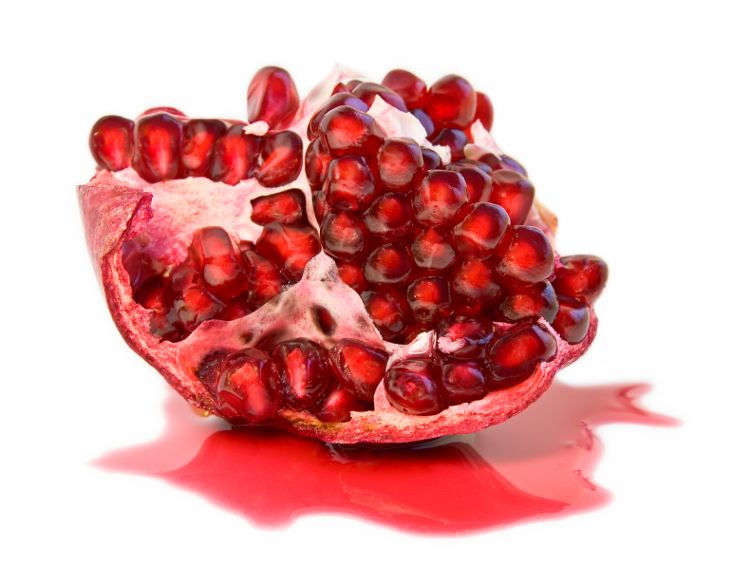Pomegranate: Is a simple and sensitive quantitation approach for its components a valid test method?
An Herbalife scientist explains why it is difficult to determine the amount of punicalagins A&B and ellagic acid simultaneously in pomegranate fruit rind.
Photo © iStockphoto.com/-AZ-

Pomegranate seeds or refreshing pomegranate juice make a delicious, refreshing snack. The fruit’s origin dates back thousands of years in what is now modern-day Iran and also in Northern India. The fruit has a hard red shell and tiny, fleshy seeds on the inside, which are used in a variety of ways, including as juices or to enhance the flavor of many dishes.
Health Benefits of Pomegranates
For many years, scientists have conducted research on the many health benefits of pomegranates and have made some incredible discoveries.
Firstly, pomegranates (Punica granatum) are full of antioxidants, compounds, and enzymes known for keeping low-density lipoprotein (LDL) or “bad” cholesterol from oxidizing and causing atherosclerosis (hardening of the arteries).1 Organic pomegranate seeds exhibit some of the same benefits as aspirin, helping to keep blood platelets from sticking together and forming dangerous blood clots.2
The fruit also works as a natural digestive aid, providing an ample supply of vitamin B-complex. This group of water-soluble vitamins includes folic acid, thiamine, riboflavin, and niacin. These vitamins help the body properly convert protein, fat, and carbohydrates into energy. Pomegranates have also been used as a traditional medicine for the treatment of pain and inflammatory conditions such as peptic ulcers.3
Punicalagins alpha and beta (punicalagins A&B) and ellagic acid, which are well-known natural products that show health benefits, are the most important bioactive chemical components in pomegranate fruit rind.4 Precise determination of the quantity of these components is critical for quality control of supplements and other products containing pomegranate, especially ones claiming the benefits derived from the fruit.
That said, it is difficult to determine the amount of punicalagins A&B and ellagic acid simultaneously in pomegranate fruit rind. In order to do so, two intermediates from punicalagins A&B interconversion must first be found and excluded as the interference, and the solvent of ellagic acid must be improved to get more solubility and stability.
A Case Study: Using the High-Pressure Liquid Chromatography (HPLC) Method for Quantitation
To assess the quantitation of punicalagins A&B and ellagic acid in pomegranate fruit rind and fruit rind extract, Herbalife Nutrition developed a simple and quick high-pressure liquid chromatography (HPLC) method. The pomegranate materials were extracted by sonication with dimethyl sulfoxide (DMSO), a solvent used in laboratories and in manufacturing, and diluted with water. Then, the amount of punicalagins A&B and ellagic acid were determined by HPLC.
This study revealed that 60%-80% DMSO in water can achieve not only great extraction efficiency, but also exclude the interference of punicalagins A and B. Its precision, accuracy, linearity, specificity, and ruggedness were validated following Association of Official Analytical Chemists (AOAC) guidance for Single Laboratory Validation Procedure.
The recoveries of punicalagins A&B and ellagic acid from pomegranate fruit rind and fruit rind extract were 84%-104%. The method is reliable for the quantitation of punicalagins A&B and ellagic acid in pomegranate fruit rind and fruit rind extract. It is suitable for the quick analysis for quality-control purposes.
Validation of the HPLC Method for the Quantitation of Punicalagins A&B and Ellagic Acid
A simple and sensitive HPLC analytical method for quantitation of punicalagins A&B and ellagic acid in pomegranate fruit rind and fruit rind extract was validated. This method is reliable and suitable. This method demonstrated excellent coefficient of determination, precision, accuracy, ruggedness, and specificity.
Larry Zeng is principal scientist, natural products methods research, global quality, at Herbalife Nutrition.
References:
- De Nigris F et al. “Effects of a pomegranate fruit extract rich in punicalagin on oxidation-sensitive genes and eNOS activity at sites of perturbed shear stress and atherogenesis.” Cardiovascular Research, vol. 72, no. 2 (January 15, 2007): 414-423
- Aviram M et al. “Pomegranate juice consumption for 3 years by patients with carotid artery stenosis reduces common carotid intima-media thickness, blood pressure and LDL oxidation.” Clinical Nutrition, vol. 23, no. 3 (June 2004): 423-433
- BenSaad LA et al. “Anti-inflammatory potential of ellagic acid, gallic acid and punicalagin A&B isolated from Punica granatum”. BMC Complementary and Alternative Medicine, vol. 17, no. 1 (January 14, 2017): 1-10
- Qu W et al. “Quantitative determination of major polyphenol constituents in pomegranate products”. Food Chemistry, vol. 132, no. 3 (June 1, 2012): 1585-1591